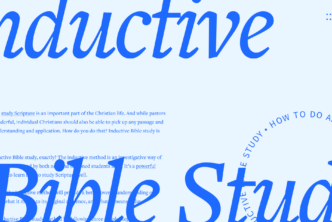What Bible study methods are the best?
First, what’s important is not how you engage with the Bible but that you do it. Because the Word of God is “living and active” (Heb 4:12)—how God chose to communicate with the people he created—the simple act of opening up your Bible and reading it allows the opportunity for personal edification and growth in understanding.
But nothing compares to digging deeper and studying the Word. Why? Because it was written 2,000+ years ago within a Middle Eastern culture and context quite different from ours today. So no matter how often we read it, we won’t fully grasp what some verses (or even entire books) mean unless we sift through them to seek understanding.
That’s where Bible study methods can help you know where to start.
Bible study involves slowing down and combing through books, passages, and verses to search out the author’s intended meaning. Asking questions of the text that will lead to deeper understanding. Considering context. It’s not to become smarter about the Bible but to know better the One who authored it.
Here are three tried-and-true Bible study methods you can use as a springboard for spending time in the Bible in the way that works best for you.
3 effective Bible study methods
1. Inductive Bible study
Inductive Bible study is probably the most well-known and exhaustive of the three study methods listed here.
It involves four steps: the ABC’s, or considering the Author, Background, and Context of a passage, followed by Observation, Interpretation, and Application.
Observation: What does this passage say?
Observation involves discovering what the passage is saying. This first step includes asking questions like:
- When did the author write the book?
- What ancient cultural influences may have shaped the passage?
- How does the passage connect with what comes before and after it?
Do the answers to these questions impact how to interpret the passage?
Interpretation: What does this passage mean?
While observation helps you discover what a passage is saying, interpretation is the process of discovering what it means. After observing the passage, look for cross-references in the Bible and seek insight from other resources like dictionaries, encyclopedias, commentaries, or study Bibles, like the Faithlife Study Bible.
In the Faithlife Study Bible, you’ll discover background information about passages that will help bridge the gap from ancient context to life today. It’s included in Logos Free Edition—plus 20 digital books, including the Lexham Bible Dictionary and The Treasury of Scripture Knowledge as well as reverse interlinears for word studies.
In DIY Bible Study, John D. Barry compares interpreting the Bible to appreciating a Monet painting. He writes, “At first, everything is a bit blurry, but once you stand farther back, you see how all the blurry shapes fit together into something beautiful.”1
And who wants the story of the Bible to be blurry?
Application: How does this passage apply to me?
As you interpret a passage and are confronted with truth, you must decide how to respond.
In this step, you take responsibility for putting into practice all you’ve gleaned from your Bible study. What truth did you discover that you did not know or understand before? Ask yourself what that new truth means for your life, priorities, and decisions.
Paul taught that God inspires all Scripture, which is profitable for teaching, reproof, correction, and training in righteousness, “so that the man of God may be adequate, equipped for every good work” (2 Tim 3:16–17). Not only will you be better equipped, but turning these nuggets of biblical truth over in your mind is also where transformation begins to take root, where the Word of God starts to direct and inform your actions. What you’ve stored upstairs in your mind will begin to form who you are—and change you to become more like Christ (Rom 8:29).
Take the time to dive into the application step. It’s worth it.
2. Topical Bible study
A topical study focuses on gaining a more comprehensive understanding of what God says on a particular subject so that what you think about it aligns with what God says about it. Dr. R. A. Torrey calls it “the most fascinating of all the methods”:
The only way to master any topic is to go through the Bible and find what it has to teach on that topic. Almost any great subject will take a remarkable hold upon the heart of a Christian if you will take the time to go through the Bible, from Genesis to revelation, and note what it has to say on that topic. You will have a more full and more correct understanding of that topic than you ever had before. —Dr. R. A. Torrey
Though not exhaustive, here are eight steps to doing a topical study.
Step 1: Pray
Regardless of which topic you choose, always start with prayer and invite the Holy Spirit to direct your study time.
Step 2: Choose a topic
There’s no end to topics you can study in the Bible (Nave’s Topical Bible contains some 20,000 of them—that’ll keep you busy for a while!). You can study anything from God’s grace or forgiveness to a more sensitive topic like abortion or divorce.
Step 3: Look up all the verses you can find on the topic.
Bible apps like Logos makes this step easy (but you can do a simple Google search, too). TIP: The Dictionary of Bible Themes includes over 2,000 topical ideas and provides references and cross-references, so you can do both steps 2 and 3 in one swoop.
Step 4: Find related words and then search for other verses that use them.
Concordances can help here. These reference tools “list the Bible’s words in alphabetical order along with their verse references in canonical order”2—you can look up your original word and all the related words you found.
Step 5: Read the verses in multiple translations.
This step helps you see different decisions translators made when translating the original languages. (Again, Bible software like Logos makes comparing Bible translations a breeze.)
Step 6: Consider the context of each verse.
John D. Barry writes: “A verse is contextualized in a passage; a passage in a biblical book; a biblical book in a particular place and time; and each time and place is characterized by language and culture.”3 That’s why you’ll want to read or scan surrounding verses, paragraphs, and even chapters to understand how a verse or passage is connected to the whole. Commentaries like Lexham Context Commentaries can shed light on the culture and context of the verse in its broader context.
Step 7: Break each verse down.
Use Bible software to do word studies to explore the original Greek/Hebrew translation. This step is paramount when doing topical studies—it helps you discover the original wording of a passage or verse so you can interpret it accurately.
Step 8: Draw conclusions
Synthesize everything you have learned and draw conclusions about what you found. Ask yourself if there’s a way to apply what you learned to your own life.
3. Book of the Bible study
Studying a book of the Bible in-depth will help you better understand the book as a whole and how it fits in the grand narrative of the Bible. After choosing which book you’re going to study, pray and ask God to direct your time in the Word. Then start with these tips.
1. Read the book from beginning to end more than once and in more than one translation.
This step aims to get a bird’s-eye view of the overall storyline and context of the book. As you read, take notes in a journal or your Bible app:
- Make a list of prominent words that repeat or seem to be connected to a broader theme.
- Continually ask yourself: Who? What? Where? When? Why? How?
- Learn the main “characters”—Paul? Jesus? Moses?
- Note any discourse markers (like “therefore” or “however”)
- Highlight any time shifts (like in John 1:35, which says, “The next day, John was standing with two of his disciples”)
- Consider shifts in geographic locations (e.g., Was Jesus just in Jerusalem, but in the next verse, he’s in the Galilee?)
Here you want to learn about the author, when the book was written, who it was written to, and the book’s purpose. You may already have an idea of overarching themes and key verses from your first read through the book, but now you’ll want to explore what different commentators and Bible scholars say. Does your insight align with theirs? How does it differ? Any new insights?
3. Do word studies of some of the words you found in Step 1.
(See Step 7 under Topical Bible study.)
4. Create an outline.
Based on your findings in tips 1–3, break chapters down into sections and give them titles and subtitles to help you see where changes in the narrative occur. You can craft an outline that is more observational (a summary of sorts with points that show the basic flow of ideas, themes, and events). Or you can create an interpretive outline (which gives structure to the text by listing the author’s main points).
5. Document or journal the insights you learned.
***
It doesn’t matter which method (or methods) you use to study the Bible. (There are more than these three!) What matters is that you do it. As James M. Boice says, Bible study “is the most essential ingredient in the believer’s spiritual life, because it is only in study of the Bible . . . that Christians hear Christ and discover what it means to follow him.”4
You might start by studying a book of the Bible with a top scholar in the Bible Survey Video Series—for under $20 each! These short, accessible video courses are pulled from Mobile Ed book study courses to give you a more solid, in-depth knowledge of individual Bible books.
Related articles
- 4 Steps to Studying the Bible in Context
- Got Big Bible Study Goals? Here’s Your Secret Weapon to Reach Them
- Why In-Depth Bible Study Doesn’t Have to Be Hard
- 4 Simple Language Principles That Will Improve Your Bible Study
- 5 Bible Study Techniques You Shouldn’t Ignore
Related resources
- Lexham Context Commentary: New Testament
- Lexham Context Commentary: Old Testament
- The Dictionary of Bible Themes
- Inductive Bible Study: A Comprehensive Guide to the Practice of Hermeneutics
- John D. Barry, DIY Bible Study: (4 vols.), (Lexham Press, Bellingham, WA), 2014), 1.
- John D. Barry, Lexham Bible Dictionary, “Concordance” (Lexham Press, Bellingham, WA) 2016.
- https://www.logos.com/grow/here-a-verse-there-a-verse-4-steps-to-studying-the-bible-in-context/
- James M. Boice, Christ’s Call to Discipleship (Kregel Publications), 2013.







